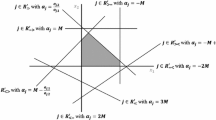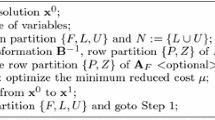Abstract
The traditional perturbation (or lexicographic) methods for resolving degeneracy in linear programming impose decision rules that eliminate ties in the simplex ratio rule and, therefore, restrict the choice of exiting basic variables. Bland's combinatorial pivoting rule also restricts the choice of exiting variables. Using ideas from parametric linear programming, we develop anticycling pivoting rules that do not limit the choice of exiting variables beyond the simplex ratio rule. That is, any variable that ties for the ratio rule can leave the basis. A similar approach gives pivoting rules for the dual simplex method that do not restrict the choice of entering variables.
Similar content being viewed by others
References
I. Adler, “The expected number of pivots needed to solve parametric linear programs and the efficiency of the self-dual simplex method,” Technical Report, Department of Industrial Engineering and Operations Research, University of California (Berkeley, CA, 1983).
I. Adler, R.M. Karp and R. Shamir, “A simplex variant solvingm × d linear programs in O(min{m 2,d 2}) expected number of pivot steps,” Report UCB CSD 83/158, Computer Science Division, University of California (Berkeley, CA, 1983).
E.M.L. Beale, “Cycling in the dual simplex algorithm,”Naval Research Logistics Quarterly 2 (1955) 259–276.
R.G. Bland, “New finite pivoting rules for the simplex method,”Mathematics of Operations Research 2 (1977) 103–107.
K.H. Borgwardt, “The average number of steps required by the simplex method is polynomial,”Zeitschrift für Operations Research 26 (1982) 157–177.
A. Charnes, “Optimality and degeneracy in linear programming,”Econometrica 20 (1952) 160–170.
G.B. Dantzig, “Maximization of a linear function of variables subject to linear inequalities,” in: T.C. Koopmans, ed.,Activity Analysis of Production and Allocation (John Wiley and Sons, New York, 1951).
G.B. Dantzig,Linear Programming and Extensions (Princeton University Press, Princeton, NJ, 1963).
M. Haimovich, “The simplex method is very good!—On the expected number of pivot steps and related properties of random linear programs,” Technical Report, Columbia University (New York, NY, 1983).
N. Megiddo, “Improved asymptotic analysis of the average number of steps performed by the self-dual simplex method,”Mathematical Programming 35 (1986) 140–172.
S. Smale, “On the average number of steps of the simplex method of linear programming,”Mathematical Programming 27 (1983) 241–262.
M.J. Todd, “Polynomial expected behavior of a pivoting algorithm for linear complementarity and linear programming problems,”Mathematical Programming 35 (1986) 173–192.
M.J. Todd, “Linear and quadratic programming in oriented matroids,”Journal of Combinatorial Theory B 39 (1985) 105–133.
P. Wolfe, “A technique for resolving degeneracy in linear programming,”Journal of SIAM 11 (1963) 205–211.
Author information
Authors and Affiliations
Additional information
Supported in part by grant ECS-83-6224 from the Systems Theory and Operations Research Division of the National Science Foundation.
Supported in part by Presidential Young Investigator grant 8451517-ECS of the National Science Foundation.
Rights and permissions
About this article
Cite this article
Magnanti, T.L., Orlin, J.B. Parametric linear programming and anti-cycling pivoting rules. Mathematical Programming 41, 317–325 (1988). https://doi.org/10.1007/BF01580770
Received:
Revised:
Issue Date:
DOI: https://doi.org/10.1007/BF01580770




